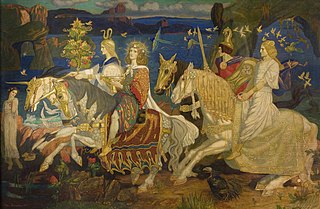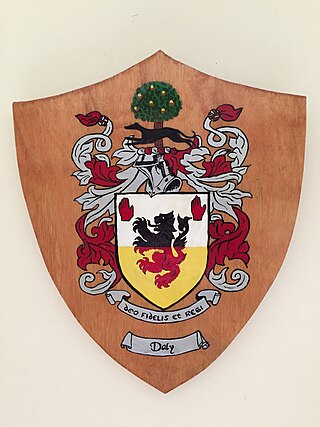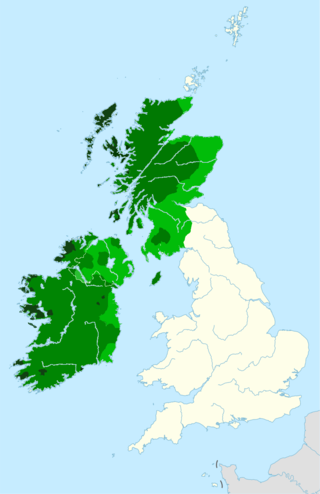
The Celtic languages are a group of related languages descended from Proto-Celtic. They form a branch of the Indo-European language family. The term "Celtic" was first used to describe this language group by Edward Lhuyd in 1707, following Paul-Yves Pezron, who made the explicit link between the Celts described by classical writers and the Welsh and Breton languages.

Irish mythology is the body of myths indigenous to the island of Ireland. It was originally passed down orally in the prehistoric era. In the early medieval era, some myths were transcribed by Christian monks, who heavily altered and Christianised the myths. Irish mythology is the best-preserved branch of Celtic mythology.

Samhain, Sauin or Oíche Shamhna is a Gaelic festival on 1 November marking the end of the harvest season and beginning of winter or "darker half" of the year. It is also the Irish language name for November. Celebrations begin on the evening of 31 October, since the Celtic day began and ended at sunset. This is about halfway between the autumnal equinox and winter solstice. It is one of the four Gaelic seasonal festivals along with Imbolc, Bealtaine, and Lughnasa. Historically it was widely observed throughout Ireland, Scotland, and the Isle of Man. A similar festival is held by the Brittonic Celtic people, called Calan Gaeaf in Wales.

Fionn mac Cumhaill, often anglicized Finn McCool or MacCool, is a hero in Irish mythology, as well as in later Scottish and Manx folklore. He is the leader of the Fianna bands of young roving hunter-warriors, as well as being a seer and poet. He is said to have a magic thumb that bestows him with great wisdom. He is often depicted hunting with his hounds Bran and Sceólang, and fighting with his spear and sword. The tales of Fionn and his fiann form the Fianna Cycle or Fenian Cycle, much of it narrated by Fionn's son, the poet Oisín.

In Gaelic myth, the Cailleach is a divine hag and ancestor, associated with the creation of the landscape and with the weather, especially storms and winter. The word literally means 'old woman, hag', and is found with this meaning in modern Irish and Scottish Gaelic, and has been applied to numerous mythological and folkloric figures in Ireland, Scotland, and the Isle of Man. In modern Irish folklore studies, she is sometimes known as The Hag of Beara, while in Scotland she is known as Beira, Queen of Winter.

Fianna were small warrior-hunter bands in Gaelic Ireland during the Iron Age and early Middle Ages. A fian was made up of freeborn young males, often from the Gaelic nobility of Ireland, "who had left fosterage but had not yet inherited the property needed to settle down as full landowning members of the túath". For most of the year they lived in the wild, hunting, cattle raiding other Irish clans, training, and fighting as mercenaries. Scholars believe the fian was a rite of passage into manhood, and have linked fianna with similar young warrior bands in other early European cultures.

Merrow is a mermaid or merman in Irish folklore. The term is anglicised from the Irish word murúch.
Tadhg, commonly anglicized as "Taig" or "Teague", is an Irish and Scottish Gaelic masculine name that was very common when the Goidelic languages predominated, to the extent that it is a synecdoche for Irish-speaking man. The name signifies "poet" or "philosopher". This was also the name of many Gaelic Irish kings from the 10th to the 16th centuries, particularly in Connacht and Munster. Tadhg is most common in southwest Ireland, particularly in County Cork and County Kerry. The name has had a surge in popularity in the early 21st century; As of 2000 it was the 92nd most common name for baby boys in Ireland, according to the Central Statistics Office, rising to 69th by 2005. By 2022, it had risen to the 7th most common name for newly registered male births.
The modern Celts are a related group of ethnicities who share similar Celtic languages, cultures and artistic histories, and who live in or descend from one of the regions on the western extremities of Europe populated by the Celts.
The Mac an Bháird family was one of the learned families of late medieval Ireland. The name has evolved over many centuries, the anglicised forms coming down as MacAward, McWard, MacEward, MacEvard, Macanward, M'Ward, and its most commonly used variant today: Ward. The name means 'son of the bard' and has no connection with the English name Ward, which originated from the Saxon word weard meaning watchman or guardian. Additionally, considerable numbers of Latin, French, and Spanish variants can be found in Continental records: Vardeo, Bardeo, U Bart, Wardeum, Vyardes, Wardeus, not to mention Verdaeorum familiae: the Ward family.

The Ó Dálaigh were a learned Irish bardic family who first came to prominence early in the 12th century, when Cú Connacht Ó Dálaigh was described as "The first Ollamh of poetry in all Ireland".
Early Irish literature, is commonly dated from the 8th or 9th to the 15th century, a period during which modern literature in Irish began to emerge. It stands as one of the oldest vernacular literature in Western Europe, with its roots extending back to late antiquity, as evident from inscriptions utilizing both Irish and Latin found on Ogham stones dating as early as the 4th century. The early Irish literary tradition flourished through the Medieval Irish period, and its literary output showcases a blend of indigenous storytelling, myth, and historical narratives. Notably, this period saw the development of a full-scale vernacular written literature expressed in a diverse range of literary genres.
Cathal is a common given name in Ireland, spelled the same in both the Irish and English languages. The name is derived from two Celtic elements: the first, cath, means "battle"; the second element, fal, means "rule". There is no feminine form of Cathal. The Gaelic name has several anglicised forms, such as Cathel, Cahal, Cahill and Kathel. It has also been anglicised as Charles, although this name is of an entirely different origin as it is derived from a Germanic element, karl, meaning "free man".

Tubridy, less commonly known as Tubrid and Tuberty, is a Gaelic Irish clan from Munster. The sept is most common along the West Coast of County Clare, but has also had some presence in County Waterford and County Tipperary. The Tubridys of Thomond are thought to have originated as scribes, as a sept of the Dál gCais, kindred to clans such as the O'Brien, O'Grady and MacNamara. The name means "descendant of Tiobraide", with the Gaelic language word tiobraid meaning "a well". Although to this day, Ireland remains the core location for the clan, it has also spread in diaspora to Great Britain, the United States, Australia, New Zealand and Canada since the 19th century.
Cín Dromma Snechtai or Lebor Dromma Snechtai is a now lost early Irish manuscript, thought to have been written in the 8th century AD.

Irish, also known as Irish Gaelic or simply Gaelic, is a Goidelic language of the Insular Celtic branch of the Celtic language group, which is a part of the Indo-European language family. Irish is indigenous to the island of Ireland and was the population's first language until the 19th century, when English gradually became dominant, particularly in the last decades of the century. Today, Irish is still commonly spoken as a first language in areas of Ireland collectively known as the Gaeltacht, in which only 2% of Ireland's population lived in 2022.

The Gaels are an ethnolinguistic group native to Ireland, Scotland and the Isle of Man. They are associated with the Gaelic languages: a branch of the Celtic languages comprising Irish, Manx and Scottish Gaelic.
Nuala na Meadóige Ní Fionnachta, Gaelic Irish woman, fl. 1390's.
Onomastics is an important source of information on the early Celts, as Greco-Roman historiography recorded Celtic names before substantial written information becomes available in any Celtic language.










